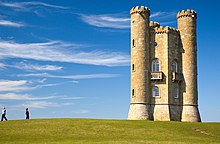


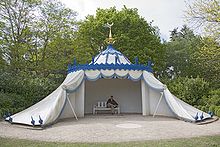
In architecture, a folly is a building constructed primarily for decoration, but suggesting through its appearance some other purpose, or of such extravagant appearance that it transcends the range of usual garden buildings.
Eighteenth-century English landscape gardening and French landscape gardening often featured mock Roman temples, symbolising classical virtues. Other 18th-century garden follies imitated Chinese temples, Egyptian pyramids, ruined medieval castles or abbeys, or Tatar tents, to represent different continents or historical eras. Sometimes they represented rustic villages, mills and cottages, to symbolise rural virtues. Many follies, particularly during times of famine, such as the Great Famine in Ireland, were built as a form of poor relief, to provide employment for peasants and unemployed artisans.
In English, the term began as "a popular name for any costly structure considered to have shown folly in the builder", the Oxford English Dictionary's definition. Follies are often named after the individual who commissioned or designed the project. The connotations of silliness or madness in this definition is in accord with the general meaning of the French word folie; however, another older meaning of this word is "delight" or "favourite abode". This sense included conventional, practical buildings that were thought unduly large or expensive, such as Beckford's Folly, an extremely expensive early Gothic Revival country house that collapsed under the weight of its tower in 1825, 12 years after completion.
As a general term, "folly" is usually applied to a small building that appears to have no practical purpose or the purpose of which appears less important than its striking and unusual design, but the term is ultimately subjective, so a precise definition is not possible.
Characteristics
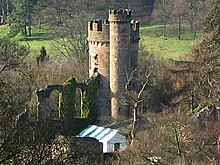
The concept of the folly is subjective and it has been suggested that the definition of a folly "lies in the eyes of the beholder". Typical characteristics include:
- They have no purpose other than as an ornament. Often they have some of the appearance of a building constructed for a particular purpose, such as a castle or tower, but this appearance is a sham. Equally, if they have a purpose, it may be disguised.
- They are buildings, or parts of buildings. Thus they are distinguished from other garden ornaments such as sculpture.
- They are purpose-built. Follies are deliberately built as ornaments.
- They are often eccentric in design or construction. This is not strictly necessary; however, it is common for these structures to call attention to themselves through unusual details or form.
- There is often an element of fakery in their construction. The canonical example of this is the sham ruin: a folly which pretends to be the remains of an old building but which was in fact constructed in that state.
- They were built or commissioned for pleasure.
History

Follies began as decorative accents on the great estates of the late 16th and early 17th centuries, but they flourished especially in the two centuries which followed. Many estates had ruins of monastic houses and (in Italy) Roman villas; others, lacking such buildings, constructed their own sham versions of these romantic structures.
However, very few follies are completely without a practical purpose. Apart from their decorative aspect, many originally had a use which was lost later, such as hunting towers. Follies are misunderstood structures, according to The Folly Fellowship, a charity that exists to celebrate the history and splendour of these often neglected buildings.
Follies in 18th-century French and English gardens
See also: Artificial ruins
Follies (French: fabriques) were an important feature of the English garden and French landscape garden in the 18th century, such as Stowe and Stourhead in England and Ermenonville and the gardens of Versailles in France. They were usually in the form of Roman temples, ruined Gothic abbeys, or Egyptian pyramids. Painshill Park in Surrey contained almost a full set, with a large Gothic tower and various other Gothic buildings, a Roman temple, a hermit's retreat with resident hermit, a Turkish tent, a shell-encrusted water grotto and other features. In France they sometimes took the form of romantic farmhouses, mills and cottages, as in Marie Antoinette's Hameau de la Reine at Versailles. Sometimes they were copied from landscape paintings by painters such as Claude Lorrain and Hubert Robert. Often, they had symbolic importance, illustrating the virtues of ancient Rome, or the virtues of country life. The temple of philosophy at Ermenonville, left unfinished, symbolised that knowledge would never be complete, while the temple of modern virtues at Stowe was deliberately ruined, to show the decay of contemporary morals.
Later in the 18th century, the follies became more exotic, representing other parts of the world, including Chinese pagodas, Japanese bridges, and Tatar tents.
Famine follies
The Great Famine of Ireland of 1845–1849 led to the building of several follies in order to provide relief to the poor without issuing unconditional handouts. However, to hire the needy for work on useful projects would deprive existing workers of their jobs. Thus, construction projects termed "famine follies" came to be built. These included roads in the middle of nowhere, between two seemingly random points, screen and estate walls, piers in the middle of bogs, etc.
Examples
See also: Category:Folly buildings

Follies are found worldwide, but they are particularly abundant in Great Britain.
Australia
Austria
- Roman ruin and gloriettes, in the park of Schönbrunn Palace, Vienna
Belgium
- Hassenspark toren in the Hassenspark in Vilvoorde, Flemish Brabant
Canada
Czech Republic

- Series of buildings in Lednice–Valtice Cultural Landscape (UNESCO World Heritage Site)
- Chinese Pavilions in chateau gardens in Vlašim, Děčín Krásný Dvůr
France
- Chanteloup Pagoda, near Amboise
- Désert de Retz, folly garden in Chambourcy near Paris, France (18th century)
- Parc de la Villette in Paris has a number of modern follies by architect Bernard Tschumi.
- The Ideal Palace of Ferdinand Cheval in Hauterives, seen as an example of naive architecture.
- Hameau de la Reine, in the park of the Château de Versailles
- The Grottoes of Ferrand, in Saint-Hippolyte, Gironde
Germany
- Bergpark Wilhelmshöhe water features
- Lighthouse in the park of Moritzburg Castle near Dresden
- Mosque in the Schwetzingen Castle gardens
- Pfaueninsel artificial ruin, Berlin
- Ruinenberg near Sanssouci Park, Potsdam
Hungary
- Bory Castle at Székesfehérvár
- Taródi Castle at Sopron
- Vajdahunyad vára in the City Park of Budapest
India
Ireland

- Ballysaggartmore Towers, County Waterford
- Carden's Folly
- Casino at Marino
- Conolly's Folly and The Wonderful Barn on the same estate
- Killiney Hill, with several follies
- Larchill in County Kildare, with several follies
- Powerscourt Estate, which contains the Pepperpot Tower
- Saint Anne's Park, which contains a number of follies
- Saint Enda's Park, former school of Patrick Pearse, contains several follies
- The Jealous Wall at Belvedere House near Mullingar, County Westmeath
- Waterloo Round Tower near Blarney, County Cork
Italy
- La Scarzuola, Montegabbione
- The Park of the Monsters (Bomarzo Gardens)
- Il Giardino dei Tarocchi near Capalbio
Jamaica
- Three follies were built on Folly Estate, Port Antonio, in 1905. They are now in ruins.
Malta
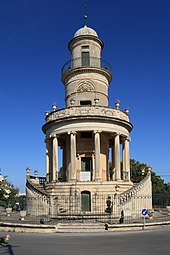
Poland
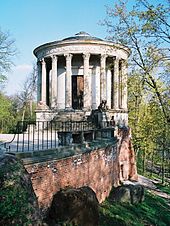
- Roman aqueduct, Arkadia, Łowicz County
- Temple of the Sibyl in Puławy
Romania
Russia
- Ruined towers in Peterhof, Tsarskoe Selo, Gatchina, and Tsaritsino
- Creaking Pagoda and Chinese Village in Tsarskoe Selo
- Dutch Admiralty in Tsarskoe Selo
Spain

Ukraine

- Ruins in Oleksandriia, Bila Tserkva
United Kingdom

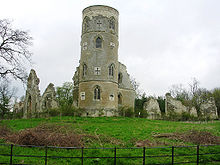

England
- Ashton Memorial, Lancaster
- Beckford's Tower, Somerset
- Blaise Castle, Bristol
- Broadway Tower, The Cotswolds
- Bettison's Folly, Hornsea
- Black Castle Public House, Bristol
- Brizlee Tower, Northumberland
- Browne's Folly, Bathford, Somerset
- The Cage at Lyme Park, Cheshire
- The Castle at Roundhay Park, West Yorkshire
- Chilton Priory, Somerset
- Clavell Tower, Dorset
- Conygar Tower, Dunster, Somerset
- Cranmore Tower, Cranmore, Somerset
- Culloden Tower, Richmond, North Yorkshire
- Faringdon Folly, Faringdon, Oxfordshire
- Flounders' Folly, Shropshire
- Forbidden Corner, North Yorkshire
- Freston Tower, arguably England's oldest folly, near Ipswich, Suffolk
- Garrick's Temple to Shakespeare, Hampton
- Gothic Tower at Goldney Hall, Bristol
- The Great Pagoda, Kew Gardens, London¨
- Hadlow Tower, Hadlow, Kent
- Hardwick Hall Country Park, County Durham contains several restored follies
- Hawkstone Park, follies and gardens in Shropshire
- Hiorne's Tower, Arundel Castle, West Sussex
- Horton Tower, Dorset
- King Alfred's Tower, Stourhead, Somerset
- Lund's Tower, Sutton-in-Craven, North Yorkshire
- Luttrell's Tower, Fawley, Hampshire
- Mow Cop Castle, Staffordshire
- Old John, Bradgate Park, Leicestershire
- Painshill, Cobham, Surrey, an 18th-century landscape garden with several follies, some modern reconstructions
- Penshaw Monument, Penshaw, Sunderland
- Pelham's Pillar, Caistor, North Lincolnshire
- Perrott's Folly, Birmingham
- Pope's Grotto, Twickenham, South West London
- Prospect Tower, Calstock, Cornwall
- Racton Monument, West Sussex
- Rogers' TowerLudgvan
- The Ruined Arch at the Royal Botanic Gardens, Kew, London
- Rushton Triangular Lodge, Northamptonshire (16th century)
- Severndroog Castle, Shooter's Hill, south-east London
- Sham Castle, Bathwick Hill, Bath, Somerset
- The Sledmere Cross takes the form of an Eleanor Cross and is a true 'folly' that was 'converted' to a World War I Memorial
- Solomon's Temple, Buxton, Derbyshire
- Stainborough Castle, South Yorkshire
- Two of the follies in Staunton Country Park have survived until the present day
- Stowe School has several follies in the grounds
- Sway Tower, New Forest
- Tattingstone Wonder, near Ipswich, Suffolk
- Wainhouse Tower, the tallest folly in the world, Halifax, West Yorkshire
- Wentworth Woodhouse, Wentworth, South Yorkshire
- Wilder's Folly, Sulham, Berkshire
- Williamson Tunnels, probably the largest underground folly in the world, Liverpool
- Wimpole’s Folly, Cambridgeshire
Scotland
- The Caldwell Tower, Lugton, Renfrewshire
- Captain Frasers Folly (Uig Tower) Isle of Skye
- Dunmore Pineapple, Falkirk
- Hume Castle, Berwickshire
- Kinnoull Hill Tower, Perth
- McCaig's Tower, Oban, Argyll and Bute
- National Monument, Edinburgh
- Shaw Monument, Prestwick
- The Temple near Castle Semple Loch, Renfrewshire
Wales

- Clytha Castle, Monmouthshire
- Derry Ormond Tower, Ceredigion
- Folly Tower at Pontypool
- Paxton's Tower, Carmarthenshire
- Portmeirion, known as the setting for several television productions including The Prisoner series
- Gwrych Castle, Conwy County Borough
United States

- Bancroft Tower, Worcester, Massachusetts
- Belvedere Castle, New York City
- Bishop Castle, outside of Pueblo, Colorado
- Coral Castle, Homestead, Florida
- Hofmann Tower in Lyons, Illinois
- Kingfisher Tower, Otsego Lake (New York)
- Körner’s Folly, Kernersville, North Carolina
- Lawson Tower, Scituate, Massachusetts
- The Parthenon in Nashville, Tennessee
- Vessel, New York, New York
- Watts Towers, Watts, Los Angeles
See also
- List of garden features
- English garden
- Folly Fellowship
- French landscape garden
- Garden hermit
- Goat tower
- Grotto
- Lustschloss
- Novelty architecture
- Ruin value
References
- Yves-Marie Allain, Janine Christiany, L'art des jardins en Europe, Citadelles & Mazenod, Paris, 2006.
- Oxford English Dictionary, 2nd ed., 1989, vol VI, p4, "Folly, 5".
- " ... and many French houses are still named "La Folie"" – OED.
- "The Castle About 3/4 Mile East of Hagley Hall". Retrieved 4 September 2016.
- Headley, Gwyn; Meulenkamp, Win (1986). Follies a National Trust Guide. Jonathan Cape. p. xxi. ISBN 0-224-02105-2.
- ^ Jones, Barbara (1974). Follies & Grottoes. Constable & Co. p. 1. ISBN 0-09-459350-7.
- Césari, Dominique. "Ermenonville". Parcs à fabriques. Retrieved 5 September 2016.
- "The Royal Oak Foundation looks to Stowe's 1730s Temple of Modern Virtue as its latest beneficiary". 17 October 2018.
- Yves-Marie Allain and Janine Christiany, L'art des jardins en Europe, Citadelles & Mazenod, Paris, 2006.
- Howley, James. 1993. The Follies and Garden Buildings of Ireland. New Haven: Yale University Press. ISBN 0-300-05577-3
- Menzies, Dean. "Folly". Hansagarten24. Retrieved 5 September 2016.
- "Heemkring hakt voor eens en voor altijd knoop door over 'toren van middeleeuwse stadsomwalling': "Ziet er authentiek uit maar het is absoluut fake"". Het Nieuwsblad Mobile (in Flemish). 25 August 2022. Retrieved 8 September 2023.
- "Paradise Lost | Casino Marino".
- http://images.library.wisc.edu/DLDecArts/EFacs/HomeDesign/hdv09n01/reference/dldecarts.hdv09n01.i0022.pdf See photos: "A Seat Shaded from the Tropic Sun" (and water tank), "A Summer House on the Hill" (with no walls), "The Bridge and Pavilion".
- Follies Magazine #108, "My Folly Folly Folly: a Jamaican Journey"
- "Sham Castle". Bath in Time. 8 February 2007. Archived from the original on 24 May 2013. Retrieved 21 November 2012.
Bibliography
- Barlow, Nick et al. Follies of Europe, Garden Art Press, 2009, ISBN 978-1-870673-56-3
- Barton, Stuart Monumental Follies Lyle Publications, 1972
- Folly Fellowship, The Follies Magazine, published quarterly
- Folly Fellowship, The Follies Journal, published annually
- Folly Fellowship, The Foll-e, an electronic bulletin published monthly and available free to all
- Hatt, E. M. Follies National Benzole, London 1963
- Headley, Gwyn Architectural Follies in America, John Wiley & Sons, New York 1996
- Headley, Gwyn & Meulenkamp, Wim, Follies — A Guide to Rogue Architecture, Jonathan Cape, London 1990
- Headley, Gwyn & Meulenkamp, Wim, Follies — A National Trust Guide, Jonathan Cape, London 1986
- Headley, Gwyn & Meulenkamp, Wim, Follies Grottoes & Garden Buildings, Aurum Press, London 1999
- Howley, James The Follies and Garden Buildings of Ireland Yale University Press, New Haven & London, 1993
- Jackson, Hazelle Shellhouses and Grottoes, Shire Books, England, 2001
- Jones, Barbara Follies & Grottoes Constable, London 1953 & 1974
- Meulenkamp, Wim Follies — Bizarre Bouwwerken in Nederland en België, Arbeiderpers, Amsterdam, 1995
External links
 Media related to Follies (architecture) at Wikimedia Commons
Media related to Follies (architecture) at Wikimedia Commons